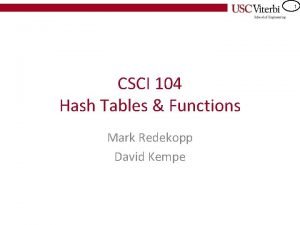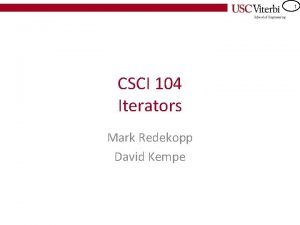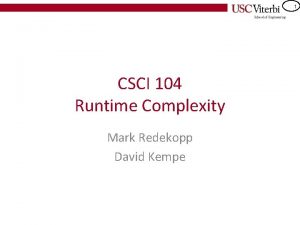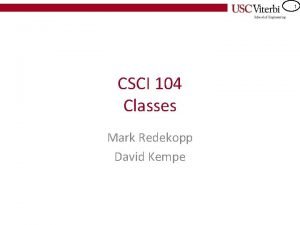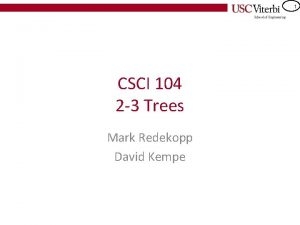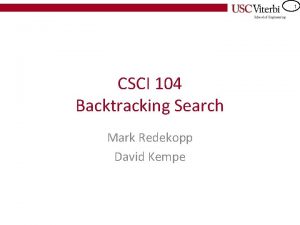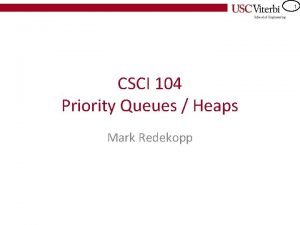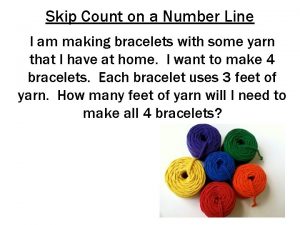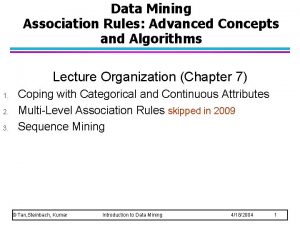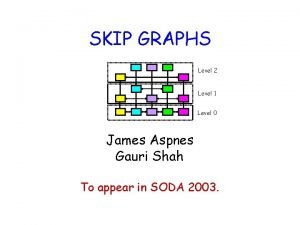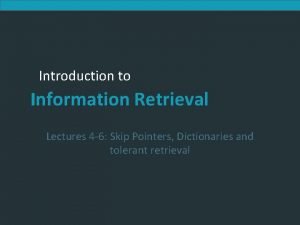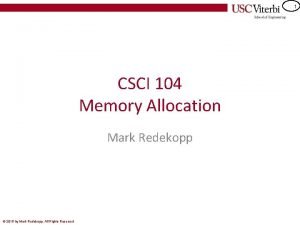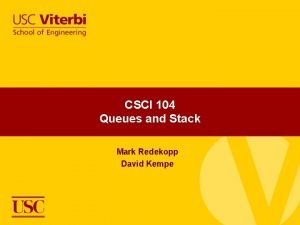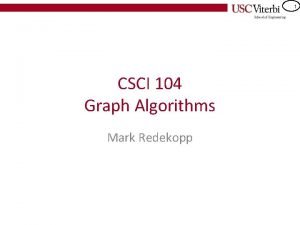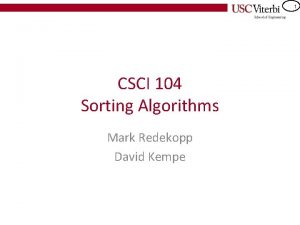1 CSCI 104 Skip Lists Mark Redekopp 2





















- Slides: 21

1 CSCI 104 Skip Lists Mark Redekopp

2 Sources / Reading • Material for these slides was derived from the following sources – http: //courses. cs. vt. edu/cs 2604/spring 02/Project s/1/Pugh. Skiplists. pdf – http: //www. cs. umd. edu/~meesh/420/Notes/Mou nt. Notes/lecture 11 -skiplist. pdf

3 Skip List Intro • Another map/set implementation (storing keys or key/value pairs) – Insert, Remove, Find • Remember the story of Goldilocks and the Three Bears – Father's porridge was too hot – Mother's porridge was too cold – Baby Bear's porridge was just right • Compare Set/Map implementations – BST's were easy but could degenerate to O(n) operations with an adversarial sequence of keys (too hot? ) – Balanced BSTs guarantee O(log(n)) operations but are more complex to implement and may require additional memory overhead (too cold? ) – Skip lists are fairly simple to implement, fairly memory efficient, and offer "expected" O(log(n)) operations (just right? ) • Skip lists are a probabilistic data structure so we expect O(log(n)) • Expectation of log(n) does not depend on keys but only random # generator

4 Skip List Visual • Think of a skip list like a sorted linked list with shortcuts (wormholes? ) • Given the skip list below with the links (arrows) below what would be the fastest way to find if 28 is in the list? H E A D 2 6 21 9 7 13 15 18 NIL 25 28

5 Skip List Visual • Think of a skip list like a sorted linked list with shortcuts (wormholes? ) • Given the skip list below with the links (arrows) below what would be the fastest way to find if 28 is in the list? – Let p point to a node. Walk at level i while the desired search key is bigger than p->next->key, then descend to the level i-1 until you find the value or hit the NIL (end node) – NIL node is a special node whose stored key is BIGGER than any key we might expect (i. e. MAXKEY+1 / +infinity) H E A D 2 6 21 9 7 13 15 18 NIL 25 28

6 Perfect Skip List • How did we form this special linked list? – We started with a normal linked list (level 0) – Then we took every other node in level 0 (2 nd node from original list) and added them to level 1 – Then we took every other node in level 1 (4 th node from the original list) and raised it to level 2 – Then we took every other node ) in level 2 (8 th node from the original list) and raised it to level 3 – There will be O(log 2(n)) levels (We would have only 1 node at level log 2(n) Level 3 Level 2 Level 1 Level 0 H E A D 2 6 21 9 7 13 15 18 NIL 25 28

7 Search Time for Perfect Skip List • How long would it take us to find an item or determine it is not present in the list – O(log(n)) • Proof – At each level we visit at most 2 nodes • At any node, x, in level i, you sit between two nodes (p, q) at level i+1 and you will need to visit at most one other node in level i before descending – There are O(log(n)) levels – So we visit at most O(2*log(n)) levels = O(log(n)) Level 3 Level 2 Level 1 Level 0 H E A D q p x 2 6 21 9 7 13 15 18 NIL 25 28

8 The Problem w/ Perfect Skip Lists • Remember in a perfect skip list – Every 2 nd node is raised to level 1 – Every 4 th node is raised to level 2 –… • What if I want to insert a new node or remove a node, how many nodes would need their levels adjusted to maintain the pattern described above? – In the worst case, all n-1 remaining nodes – Inserting/removing may require n-1 nodes to adjust Level 3 Level 2 Level 1 Level 0 H E A D q p x 2 6 21 9 7 13 15 18 NIL 25 28

9 Quick Aside • Imagine a game where if you flip a coin and it comes up heads you get $1 and get to play again. If you get tails you stop. • What's the chance you win at least – $1 – $2 – $3 • P($1)=1/2, P($2)=1/4, P($3)=1/8

10 Randomized Skip Lists • Rather than strictly enforcing every other node of level i be promoted to level i+1 we simply use probability to give an "expectation" that every other node is promoted • Whenever a node is inserted we will promote it to the next level with probability p (=1/2 for now)…we'll keep promoting it while we get heads • What's the chance we promote to level 1, 2, 3? • Given n insertions, how many would you expect to be promoted to: – Level 1 = n/2, Level 2 = n/4, Level 3 = n/8

11 Randomized Skip List • As nodes are inserted they are repeating trials of probability p (stopping when the first unsuccessful outcome occurs) • This means we will not have an "every other" node promotion scheme, but the expected number of nodes at each level matches the non-randomized version • Note: This scheme introduces the chance of some very high levels – We will usually cap the number of levels at some MAXIMUM value – However the expected number of levels is still log 2(n) Level 4 Level 3 Level 2 Level 1 Level 0 H E A D 15 2 6 7 9 13 18 NIL 21 25 28

12 Worst Case • What might a worst case skip list look like? – All the same height – Or just ascending or descending order of height • These are all highly unlikely Level 4 Level 3 Level 2 Level 1 Level 0 H E A D 2 4 NIL 7 9 13 15 18 24 25 28

13 Analysis Option A: If we can move up we do • To analyze the search time with this randomized approach let's start at the node and walk backwards to the head node counting our expected number of steps 21 Option B: No higher level, move left – Recall if we can move up a level we do, so that we take the "faster" path and only move left if we can't move up Level 4 Level 3 Level 2 Level 1 Level 0 H E A D 15 2 6 7 9 13 18 21 28 NIL 21 25 28

14 Analysis Option A: If we can move up we do • Probability of Option A: p – Recall we added each level independently with probability p • Probability of Option B: 1 -p • For this analysis let us define the top level at level 0 and the current level where we found our search node as level k (expected max k = log 2(n)) 21 Option B: No higher level, move left 21 Level 0 Level 1 Level 2 Level 3 Level 4 H E A D 15 2 6 7 9 13 18 28 NIL 21 25 28

15 Analysis Option A: If we can move up we do • Define a recurrence relationship of the cost of walking back from level k to level 0 • Base case: C(0) = O(1) 21 – Only expect 1 node + head node at level 0 Option B: No higher level, move left • Recursive case: C(k) = (1 -p)(1+C(k)) + p(1+C(k-1)) – 1+C(k) = Option B and its probability is (1 -p) – 1+C(k-1) = Option A and its probability is p Level 0 Level 1 Level 2 Level 3 Level 4 C(k) = 1+C(k-1) 21 28 C(k) = 1+C(k) H E A D 15 2 6 7 9 13 18 NIL 21 25 28

16 Analysis Option A: If we can move up we do • Solve C(k) = (1 -p)(1+C(k)) + p(1+C(k-1)) – C(k) = (1 -p) + (1 -p)C(k) + p. C(k-1) – p. C(k) = 1 + p. C(k-1) – C(k) = 1/p + C(k-1) – = 1/p + C(k-2) – = 1/p + C(k-3) – = k/p – = log 2(N) / p = O(log 2(N)) Level 0 Level 1 Level 2 Level 3 Level 4 H E A D 21 Option B: No higher level, move left 21 6 7 9 13 28 C(k) = 1+C(k) 15 2 C(k) = 1+C(k-1) 18 NIL 21 25 28

17 Node & Class Definition • Each node has an array of "forward" ("next") pointers • Head's key doesn't matter as we'll never compare it • End's forward pointers don't matter since its key value is +INF template < class K, class V > struct Skip. Node{ K key; V value; Skip. Node** forward; //array of ptrs Skip. Node(K& k, V& v, int level){ key = k; value = v; forward = new Skip. Node*[level+1]; } }; template < class K, class V > class Skip. List{ int max. Level; // data members Skip. Node* head; Skip. List(int max){ max. Level = max; head = new Skip. Node(dummy, max. Level); Skip. Node* end = new Skip. Node(INFINITY, dummy, max. Level); for(int i=0; i < max. Level; i++){ header->forward[i] = end; } } H }; E A D NIL

18 Search Pseudocode template < class K, class V > Skip. Node<K, V>* Skip. List<K, V>: : search(const Key& key){ Skip. Node<K, V>* current = head; for(int i=max. Level; i >= 0; i--){ while( current->forward[i]->key < key){ current = current->forward[i]; } } // will always stop on level 0 w/ current=node // just prior to the actual target node or End node current = current->forward[0]; if(current->key == key) return current; else return NULL; // key is not in the list } • search(28) would stop the for loop with current pointing at node 25, then take one more step Level 4 Level 3 Level 2 Level 1 Level 0 H E A D 15 2 6 7 9 13 18 NIL 21 25 28

19 Insert Pseudocode template < class K, class V > void Skip. List<K, V>: : insert(const Key& key, const Value& v){ Skip. Node<K, V>* current = head; vector<Skip. Node<K, V>*> update(max. Level+1); // perform typical search but fill in update array. . . current = current->forward[0]; if(current->key == key) { current->value = v; return; } else { int height = random. Level(); // Allocate new node, x for(int i=0; i < height; i++){ x->forward[i] = update[i]->forward[i]; update[i]->forward[i] = x; } } • insert(25) • As we walk we'll fill in an "update" array of the last nodes we walked through at each level since these will need to have their pointers updated Level 4 Level 3 Level 2 Level 1 Level 0 p H E A D 15 2 6 7 9 13 18 update array p q q q 21 q 28 q NIL

20 Insert Pseudocode template < class K, class V > int Skip. List<K, V>: : random. Level() void Skip. List<K, V>: : insert(const Key& key, { const Value& v){ int height = 1; Skip. Node<K, V>* current = head; // assume rand() returns double in rangevector<Skip. Node<K, V>*> [0, 1) update(max. Level+1); while(rand() < p && height < max. Level) // perform typical search but fill in update array height++; . . . return height; current = current->forward[0]; } if(current->key == key) { current->value = v; return; } else { int height = random. Level(); // Allocate new node, x for(int i=0; i < height; i++){ x->forward[i] = update[i]->forward[i]; update[i]->forward[i] = x; } } • random. Level returns a height >h with probability (1/ph) Level 4 Level 3 Level 2 Level 1 Level 0 p H E A D 15 2 6 7 9 13 18 update array p q q q 21 q 25 q NIL 28

21 Summary • Skip lists are a randomized data structure • Provide "expected" O(log(n)) insert, remove, and search • Compared to the complexity of the code for structures like an RB-Tree they are fairly easy to implement • In practice they perform quite well even compared to more complicated structures like balanced BSTs
 For skip pointer more skip leads to
For skip pointer more skip leads to Mark redekopp
Mark redekopp Xkcd tommy tables
Xkcd tommy tables Csci 104
Csci 104 Mark redekopp
Mark redekopp Mark redekopp
Mark redekopp Mark redekopp
Mark redekopp Mark redekopp
Mark redekopp Mark redekopp
Mark redekopp Mark redekopp
Mark redekopp Mark redekopp
Mark redekopp Mark redekopp
Mark redekopp Game development lifecycle
Game development lifecycle Skip graph
Skip graph Skip list
Skip list Skip counting number lines
Skip counting number lines Skip this
Skip this Types of attributes in data mining
Types of attributes in data mining Skip graph
Skip graph Which is a good idea for using skip pointers
Which is a good idea for using skip pointers Skip rochefort
Skip rochefort Skipdraw
Skipdraw

